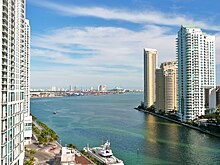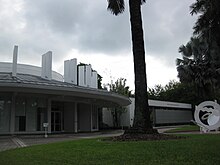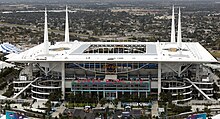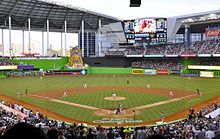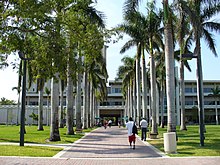Miami
In 1836, the U.S. built Fort Dallas on the banks of the Miami River as part of their development of the Florida Territory and their attempt to suppress and remove the Seminoles.
Julia Tuttle subsequently convinced railroad tycoon Henry Flagler to extend his Florida East Coast Railway to the region, for which she became known as "the mother of Miami".
When World War II began, Miami became a base for U.S. defense against German submarines due to its prime location on the southern coast of Florida.
[33] After Fidel Castro rose to power in Cuba following the Revolution in 1959, many wealthy Cubans sought refuge in Miami, further increasing the city's population.
The area's educational and cultural institutions also developed significantly in this period, positioning the city to service a larger and increasingly international population.
At the same time, South Florida weathered social problems related to drug wars, immigration from Haiti and Latin America, and the widespread destruction of Hurricane Andrew.
Several parallel lines of reef formed along the edge of the submerged Florida plateau, stretching from the present Miami area to what is now the Dry Tortugas.
[39] Beneath the plain lies the Biscayne Aquifer, a natural underground source of fresh water that extends from southern Palm Beach County to Florida Bay.
The heart of the city is Downtown Miami, which is on the eastern side and includes the neighborhoods of Brickell, Virginia Key, Watson Island, and PortMiami.
Downtown Miami is Florida's largest and most influential central business district, with many major banks, courthouses, financial headquarters, cultural and tourist attractions, schools, parks, and a large residential population.
[42] The northern side of Miami includes Midtown, a district with a great mix of diversity ranging from West Indians to Hispanics to European Americans.
[44] The northern side of Miami also has notable African-American and Caribbean immigrant communities, including Little Haiti, Overtown (home of the Lyric Theater), and Liberty City.
[62][63][64] Other potential impacts of climate change include higher hurricane wind speeds and severe thunderstorms, which can bring about hail or tornadoes.
Throughout the latter half of the twentieth century, Miami experienced a certain amount of stagnation in its population, with expansion slowing during the 1950s and 1960s before nearly halting in the next three decades as suburbanization occurred.
From 1970 to 2000, population growth in Miami was stagnant, as non-Hispanic White Miamians left and significant immigration from Latin America, particularly Cuba, made up the balance.
Over 1,400 multinational firms are located in Miami, with many major global organizations headquartering their Latin American operations (or regional offices) in the city including Walmart.
[133] Companies based in nearby cities or unincorporated areas of Miami-Dade County include, Benihana, Burger King, Carnival Cruise Line, Navarro Discount Pharmacies, Perry Ellis International, Ryder, Sedano's, UniMás, and U.S. Century Bank.
[146] Miami International Airport (IATA: MIA) and PortMiami are among the nation's busiest ports of entry, especially for cargo from South America and the Caribbean.
Miami is the home to the National Hurricane Center and the headquarters of the United States Southern Command, responsible for military operations in Central and South America.
[148] In the 2012 census, Miami had the fourth highest percentage of family incomes below the federal poverty line out of all large cities in the United States, behind Detroit, Cleveland, and Cincinnati, respectively.
[218] Miami has numerous marinas, rivers, bays, canals, and the Atlantic Ocean, which make boating, canoeing, sailing, and fishing popular outdoor activities.
[236] The commission's regular meetings are held at Miami City Hall, which is located at 3500 Pan American Drive on Dinner Key in the neighborhood of Coconut Grove.
For much of the 20th century, Miami and its surrounding area, Miami-Dade County, were solidly Democratic, reflecting the city's diverse population and liberal political leanings.
[237] Then in the 2022 Florida gubernatorial election, Ron DeSantis won the county for the first time for a Republican candidate since 2002 and only lost the city of Miami by one-and-a-half points.
[240] While the city did not fully switch to Republican control, the narrowing margin underscored the growing support for Trump among Miami's voters, particularly those of Cuban and other Latin American origins.
[241][failed verification] The political transformation in Miami and Miami-Dade County is part of a larger trend of changing dynamics among Hispanic voters in the United States.
Historically, this demographic group leaned toward the Democratic Party, but recent shifts suggest that Republicans are increasingly appealing to these voters, especially through rhetoric and policies that resonate with their concerns about immigration, economic opportunity, and law and order.
[242][failed verification] As the political landscape of Miami continues to evolve, its future as a bellwether for the broader Hispanic vote remains uncertain.
[citation needed] M-DCPS is also one of a few public school districts in the United States to offer optional bilingual education in Spanish, French, German, Haitian Creole, and Mandarin Chinese.
In 2007, Miami was identified as having the rudest drivers in the United States, the second year in a row to have been cited, in a poll commissioned by automobile club AutoVantage.


